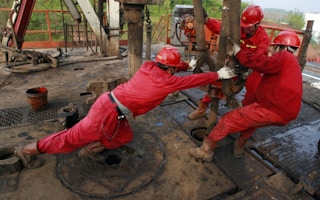Across Western Pennsylvania and West Virginia, fracking wells periodically burst out of the green scenery, little man-made islands heaving with activity in the middle of grazing lands. Trucks ferrying fracking equipment are ubiquitous on the back roads, some with Wild West names such as ‘Stallion’ and ‘GoFrack’, others with lazy monikers like ‘Key Energy’ and ‘Basic Energy’.
US companies’ keenness to be part of this new gold rush is palpable, and is mirrored thousands of miles away in Shanxi Province, China, at the country’s state-owned coking coal companies. Except that in Shanxi Province, barren, brown landscapes assault the eyes with no visible evidence of any fossil fuel activity other than coal. While the US is fracking its way to energy supremacy (at least the fossil fuel kind) via more than 400,000 shale gas wells drilled so far, China, the world’s fourth-largest natural gas consumer, has so far only drilled 150 wells. India has drilled none, and the EU-28 have drilled very few.
China, India and the EU are all wondering how they will respond to this US energy revolution. But while they may dream of replicating America’s fracking frenzy, they will soon find that this isn’t possible. Indeed, shale gas being a ‘bridge’ to a cleaner world is a myth: the US will continue to successfully extract it, thus resulting in more methane emissions but also in cheaper US energy. As a result, cheap coal America no longer needs will continue to be diverted overseas, locking coal infrastructure for decades.
India’s miserable track record of extracting coal bed methane (an underground fracking process similar to that used for shale gas) speaks volumes: after a decade of exploration, the country has a paltry haul to show for its efforts. Land acquisitions are nightmarish; the population density 10 times that of the US and its regulatory framework doesn’t work. Water scarcity doesn’t help either, and will get more difficult when the country shifts its attention to shale (which requires perhaps 20 times more water to extract than coal bed methane). One can anticipate the emerging conflicts over water with the local population when the drillers turn up in force.
In China, shale gas reserves are a technological challenge of a different order than in the US, due to complex geology, a far greater earthquake risk, loud local environmental awareness, high population density, and water shortages. It will take a long time to move past these challenges. Sichuan Province, where China’s fracking industry is taking-off, is a hotbed of seismic activity and it’s not difficult to guess what will happen when the local population wakes up to see hydraulic wells awkwardly sprouting in a province all too familiar with earthquakes’ human and environmental costs.
In the EU-28, debate is raging about fracking. France and the Netherlands have banned the practice, whereas the UK, Denmark and Poland seem keen. But below the surface hiss any number of problems. The production sharing contract used throughout most of Europe’s energy projects, which would split the benefits of extraction between different parties including landowners and communities, doesn’t work for shale. Similarly, different property rights frameworks will cause dramatic hold ups. While US frackers have bought out tens of thousands of landowners, you can’t lease your mineral rights as a private landowner in most of Europe and local councils invariably have a loud say. Add the lack of infrastructure to carry the gas and increased dissent from local and environmental groups, and it’s not difficult to conclude that fracking will not take off in any meaningful sense for a decade or more.
Like an under-performing drug, what we are left with are the side-effects of fracking. Unwanted US coal is flooding the world and delivering a perverse gas-to-coal switch in Europe and elsewhere. In turn, this is causing increased emissions outside the US and logically making coal-fired power plants more desirable in the EU, China, India and elsewhere. Meanwhile, in the US, the debate is raging about whether the industry is disclosing the correct number of wells it is drilling and what the actual methane emissions contribution of the industry is (my guess: huge).
The only way out of this vicious circle is for Europe, China and India to realize that fracking is a pipe dream and focus on developing viable renewable energy sources while curbing their addiction to fossil fuels. Policymakers must not let shale gas become a smokescreen obscuring the need for robust emissions reduction policies. EU leaders should take decisive action to fix their continent’s ailing carbon market, currently crippled by a rock-bottom carbon price. India and China should change tack and lead the world’s climate change negotiations towards decisive action.
Exporting the US shale gas model is a pipe-dream which if indulged will push the world down the path to climate chaos - truly an international nightmare.
Follow Assaad Razzouk on Twitter: @AssaadRazzouk. This post originally appeared here.











